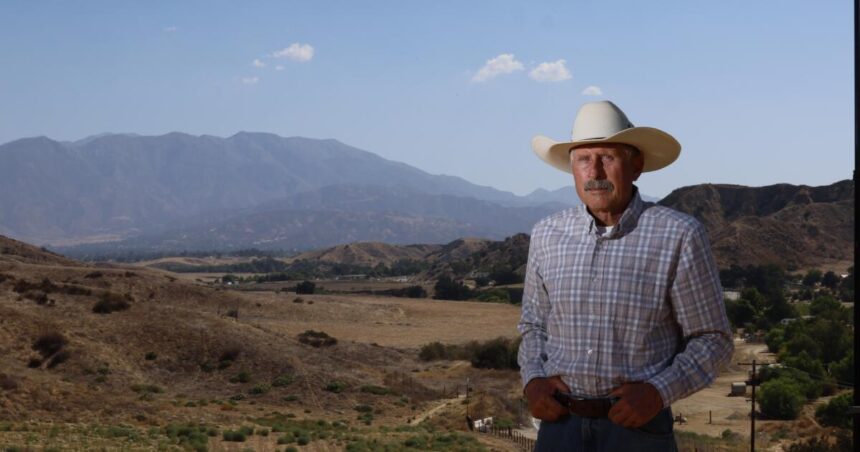When David Matuszak looks out over Live Oak Canyon from his 4-acre horse ranch, he sees expansive views of his farm’s fields and grazing cattle. For nearly 40 years, he’s been riding trails dotted with coastal oak, chamis and buckwheat and framed by the snowcapped mountains of the San Gorgonio Wilderness.
“This is one of the most scenic areas in Southern California,” says the author and former high school teacher who also serves as president of Friends of Live Oak Canyon, a grassroots environmental homeowners association.
But Matuszak and others worry that all that could change if the city of Yucaipa approves plans to build two giant warehouses on undeveloped land about a mile from Matuszak’s ranch. They say the plans would destroy natural space, diminish the town’s rural character and increase traffic congestion and air pollution. They worry the plans are part of city officials’ plan to turn Yucaipa into a logistics hub for the Inland Empire, dominated by giant fulfillment centers and roaring diesel trucks.
“That’s exactly what we’re worried about – that we’re going to be the next Fontana, Ontario or San Bernardino,” said Cathy Sellers, a former San Bernardino court reporter who has lived in Yucaipa for 38 years. “That’s why we all live here, to get away from that.”
San Bernardino and Riverside counties are already home to an estimated 4,000 warehouses covering about 37 square miles, making them the largest contiguous cluster on the planet, according to data released last year by environmental groups. The sprawling swath of east Los Angeles sits near highways and rail spurs that carry freight to and from Los Angeles and Long Beach. The explosion of e-commerce during the COVID-19 pandemic has further fueled demand for distribution centers.
The rise in warehouse development is increasing cancer risks and destroying green spaces that serve as natural carbon sinks. More than 60 groups, including Friends of Live Oak Canyon, signed a petition calling the surge one of the most significant environmental justice issues facing the region and urging Gov. Gavin Newsom to declare a state of emergency over the public health impacts.
Already, the Inland Empire is consistently rated among the best in the country, and Timothy Mullins, who moved to Yucaipa 25 years ago to escape development in the Redlands, said the region has been battling high levels of diesel particulate matter.
“If this project goes ahead, it will put even more strain on us and the health of our community will suffer,” he said.
Until recently, Yucaipa has largely escaped such development. Now, a 363,000-square-foot warehouse near the border with Calimesa is scheduled for completion within the next two to three months. The project currently under consideration, dubbed Pacific Oaks Commerce Center, would consist of two buildings of about 1 million square feet each and, according to traffic studies, would generate about 1,100 truck trips daily.
The project would be a financial boon for a city struggling with a widening budget deficit and with officials planning cuts to public safety and community services if a sales tax increase fails to pass on the November ballot.
Benjamin Matlock, Yucaipa’s city planner and deputy director of community development, said the developer will pay about $14 million in impact fees and invest millions more in infrastructure improvements, such as installing water mains and widening parts of Live Oak Canyon Road. That will make it easier for the city to attract other projects to the area, including badly needed housing, he said. The developer also agreed to fund a ladder truck for the Yucaipa Fire Department, he said.
Dan Floriani, co-founder of project developer Pacific Industrial, said the infrastructure upgrades will total more than $37 million but will be funded without taxes or bonds. The project will include 96 acres of permanent open space with walking trails for public use. An economic impact analysis by a third-party consultant estimates it will create 1,200 to 1,600 permanent jobs, he said in an email.
Edward Timmons, whose children have lived in Yucaipa for five generations, used to work as a manager at a large fulfillment center in Rialto. He says the jobs were low-wage, low-skill, and had high turnover. “The average employee stays about three months, the average manager stays four to six months,” he says. “It’s not a place to build a career. It’s a place to fill a void until you find a better job.”
He also questioned whether the project would have the long-term economic benefits the city hopes for, as the local logistics industry has cooled since the pandemic, with warehousing and storage jobs down for the first time in more than two decades and vacant space in industrial buildings on the rise, according to the city’s Wall Street Journal.
Timmons, who now works as a real estate broker and mortgage lender, collected listings within a 30-mile radius of Yucaipa and counted about 27 million square feet of available warehouse space for warehouses larger than 250,000 square feet.
Timmons and other residents said discussions between the city and the developer have been ongoing for four years, but many locals were unaware until the proposal was presented to the Planning Commission in June. In July, the commission voted 3-2 not to recommend the plan.
“Nobody wants this,” Timmons said.
For the project to move forward, the Yucaipa City Council must approve it and update its 2008 plan, which dictates how the city’s freeway corridor — a 1,200-acre area bisected by Interstate 10 — will be developed. The council is scheduled to vote on September 23.
Matlock, the city planner, said the 2008 plan already allows for the warehouses in certain areas. The proposed updates would change the location of the warehouses from closer to the highway to a more discreet location. He added that the developer went to an “exhaustive effort” to design the site so that it would be adjacent to a wastewater treatment plant and tucked behind a hill.
Christine Mohler, who was part of the committee that drafted the 2008 freeway corridor plan during its two-year run, said the choice to zone retail, commercial and industrial activities next to the highway was intentional “so that if people go up and down the highway to shop and do things like that, it doesn’t have as much of an impact on the residential areas and the property.”
The original plan earmarked the inner portion of the corridor for housing and open space, but the proposed renovation would see the warehouse project as the focal point, with housing built around it, she said.
“It’s just absurd in that area,” she said. “What was originally planned, to be very efficient and as out of the way as possible, has turned into a giant warehouse hub, which is not at all what we had in mind.”
The warehouses wouldn’t be visible from the highway but would be visible from nearby trails and open spaces, said Sherri Leonard, president of the Redlands Conservation Association, a nonprofit that manages a 341-acre preserve about a half-mile from the proposed facility and a 70-acre preserve nearby.
“The scenery is beautiful,” she says, “and not just beautiful, it actually has a positive effect on the human psyche. Watch any car commercial; you never see people driving through warehouse districts or residential areas.”
The land designated for the complex is privately owned and not open to the public, but it is a wildlife corridor home to mountain lions, coyotes, foxes, bobcats and the occasional bear, she said.
“Not only does it do significant damage to the environment, to habitat, but it also opens the door to more of this kind of thing happening, and that’s from a conservation standpoint,” she said. “From everyone’s perspective, it’s bringing 18-wheeler trucks onto a highway exit that’s already heavily congested at many times of the day, and there’s no way to mitigate that, you just have to deal with it.”
When Matuszak moved to Yucaipa in 1977 to teach exercise science and biomechanics at the local high school, the nearby communities of San Bernardino and Redlands were sprawling orange groves and fields where farmers grew strawberries and onions, he said.
“Right now we have miles and miles of these warehouses, with concrete roofs, concrete walls, concrete parking lots,” he said, which he said creates a heat island effect that contributes to global warming and can raise local temperatures by several degrees.
“They’re starting to try to extend what they’re calling the logistics hub of the world into our region,” he said. “We’re outraged by this, and we’re going to do everything in our power to stop that from happening.”









